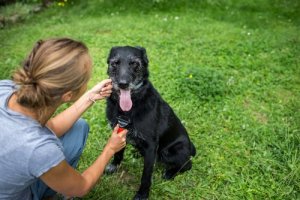Tea Tree Oil as a Treatment Against Parasites


Written and verified by the lawyer Francisco María García
Tea tree oil is wonderful as a treatment against parasites. This oil is obtained from the distillation of the leaves of the tea tree through a method that’s been around for thousands of years: steam distillation.
This distillation technique is great for extracting the essence of the leaves at its purest levels. Furthermore, a ton of tea tree leaves will yield approximately 21 pints of oil. Among all the varieties of tea tree oil, the one extracted from Melaleuca alternifolia is the only one that offers benefits to mammals.
Tea tree oil has antiseptic properties. Also, it’s a balsamic salve with bactericide, fungicide and antiviral properties among others. It’s for this reason that it’s a great ally in the treatment against parasites and bacteria.
This oil is 100% natural and there are no known side effects such as skin rashes or itching. But if you or your pet are itchy after using it then discontinue the treatment and seek medical advice.
The many healing properties of tea tree oil on skin conditions is widely recognized. Also, it’s not only excellent in the treatment against parasites but also against all sorts of allergies.
Other properties of tea tree oil

A topical solution made with manuka honey blended with tea tree oil is often used in the treatment of infected wounds and skin lesions.
In addition to this, tea tree oil is highly effective against fleas and other parasites. These turn away as soon as they notice the presence of this product on a given animal. With this in mind, spray the dog outside of their bedding; if not it’ll become infested with the runaway fleas.
Tea tree oil is an essential substance to keep in your medicine cabinet. As you well know, pets are prone to having some kind of parasite or another at some point in the near future.
Do wash your hands after handling this oil in order to avoid contact with your eyes or your pet’s.
Tea tree oil lotion
Tea tree oil lotion is easily found in pharmacies, health food stores, and even in some makeup stores. But, if you can’t find it for some reason then you can make an effective one at home. In this way, you and your animal can avoid the inconveniences caused by bacteria and parasites. To make this lotion you’ll need:
Ingredients
- 95% Everclear alcohol or rubbing alcohol
- Tea tree oil
- Distilled water
Preparation
- Mix equal parts of rubbing alcohol, tea tree oil, and distilled water.
- Then, pour it in an empty, clean spray bottle.
- Next, spray it directly on the animal. Make sure to keep it away from their eyes.
- Keep the animal away from its bedding or other usual resting places for 15 minutes, at least.
- Finally, the treatment is complete as soon as the lotion dries off their coat.
Even though this is a highly effective product, you may need to repeat the treatment for a few days until all the bloodsuckers disappear.
Tea tree oil as a treatment against parasites: Consult your vet

When it comes to flea treatments, you should consult your veterinarian to obtain advice about the products available for you to use. They’ll prescribe them according to the species, age, size, and individual clinical history. Keep in mind that most flea control products on the market are highly toxic for both your pet and for the environment.
Get in the habit of reading the labels for every product you buy and also carefully follow the instructions. This way you’ll avoid complications and unpleasant surprises.
Current research shows that tea tree oil is safe and effective in dogs and cats, but only when properly diluted in water. The recommended proportion is 0.1 – 1% for topical use. It isn’t safe to administer it internally.
Tea tree oil is wonderful as a treatment against parasites. This oil is obtained from the distillation of the leaves of the tea tree through a method that’s been around for thousands of years: steam distillation.
This distillation technique is great for extracting the essence of the leaves at its purest levels. Furthermore, a ton of tea tree leaves will yield approximately 21 pints of oil. Among all the varieties of tea tree oil, the one extracted from Melaleuca alternifolia is the only one that offers benefits to mammals.
Tea tree oil has antiseptic properties. Also, it’s a balsamic salve with bactericide, fungicide and antiviral properties among others. It’s for this reason that it’s a great ally in the treatment against parasites and bacteria.
This oil is 100% natural and there are no known side effects such as skin rashes or itching. But if you or your pet are itchy after using it then discontinue the treatment and seek medical advice.
The many healing properties of tea tree oil on skin conditions is widely recognized. Also, it’s not only excellent in the treatment against parasites but also against all sorts of allergies.
Other properties of tea tree oil

A topical solution made with manuka honey blended with tea tree oil is often used in the treatment of infected wounds and skin lesions.
In addition to this, tea tree oil is highly effective against fleas and other parasites. These turn away as soon as they notice the presence of this product on a given animal. With this in mind, spray the dog outside of their bedding; if not it’ll become infested with the runaway fleas.
Tea tree oil is an essential substance to keep in your medicine cabinet. As you well know, pets are prone to having some kind of parasite or another at some point in the near future.
Do wash your hands after handling this oil in order to avoid contact with your eyes or your pet’s.
Tea tree oil lotion
Tea tree oil lotion is easily found in pharmacies, health food stores, and even in some makeup stores. But, if you can’t find it for some reason then you can make an effective one at home. In this way, you and your animal can avoid the inconveniences caused by bacteria and parasites. To make this lotion you’ll need:
Ingredients
- 95% Everclear alcohol or rubbing alcohol
- Tea tree oil
- Distilled water
Preparation
- Mix equal parts of rubbing alcohol, tea tree oil, and distilled water.
- Then, pour it in an empty, clean spray bottle.
- Next, spray it directly on the animal. Make sure to keep it away from their eyes.
- Keep the animal away from its bedding or other usual resting places for 15 minutes, at least.
- Finally, the treatment is complete as soon as the lotion dries off their coat.
Even though this is a highly effective product, you may need to repeat the treatment for a few days until all the bloodsuckers disappear.
Tea tree oil as a treatment against parasites: Consult your vet

When it comes to flea treatments, you should consult your veterinarian to obtain advice about the products available for you to use. They’ll prescribe them according to the species, age, size, and individual clinical history. Keep in mind that most flea control products on the market are highly toxic for both your pet and for the environment.
Get in the habit of reading the labels for every product you buy and also carefully follow the instructions. This way you’ll avoid complications and unpleasant surprises.
Current research shows that tea tree oil is safe and effective in dogs and cats, but only when properly diluted in water. The recommended proportion is 0.1 – 1% for topical use. It isn’t safe to administer it internally.
This text is provided for informational purposes only and does not replace consultation with a professional. If in doubt, consult your specialist.








